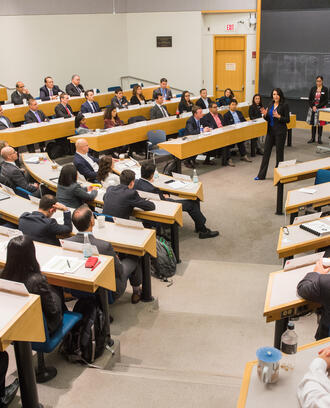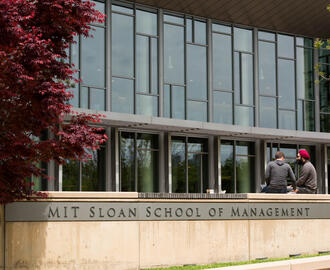MIT Executive MBA
Innovation
Never let a crisis go to waste: A quick guide to hacking the new norm
By
Greek philosopher Plato once said, “Necessity is the mother of invention.” During COVID-19, business and government leaders alike have been hard pressed to quickly re-invent their business models during unprecedented times.This was especially true of the construction industry, which -- alongside other industries such as healthcare, utilities, and financial services -- was deemed an “essential” service. Construction companies had to quickly figure out ways to mitigate COVID-19 risks on construction sites to protect workers, while maintaining morale and delivering on the infrastructure needs of the country.
The MIT EMBA advantage
As my construction company navigated through this extraordinary time, I drew on my MIT EMBA experience for ideas and strategies, particularly from a course called Innovation-Driven Entrepreneurial Advantage (IDEA). This academic experience offers an integrated look at innovation and entrepreneurship for startups and large firms. It uses the hackathon framework to go from ideation to viable business solutions quickly. In a nutshell, participants in a hackathon pitch business ideas to one another, vote on the best ideas, and then work together in teams to further develop those ideas into products and business pitches. Using this structured approach to problem solving, my classmates and I went from the process of ideation to implementation – all in the course of one week. That is exactly what we needed to do during the pandemic: Use an entrepreneurial mindset and innovative thinking to generate ideas that could quickly become real solutions.
The challenge
Inspired by the IDEA course, we decided to run a hackathon with our summer interns to create solutions for COVID-related problems. Our focus was addressing operational challenges, such as required personal protective equipment (PPE), social distancing, sanitization, timely notification of potential personnel exposures, and accurate contact tracing. With the support of our company’s Technology and Innovation Council, we launched an eight-week-long hackathon with our 51 college interns, and we called the event “Hack the New Norm.”
Step 1: Ideation
The journey started by randomly assigning interns into working teams of six to seven people each. The interns’ first step was to generate solutions individually and present their ideas to one another in one-minute pitches. Team members voted on the best ideas until they agreed on one concept to collectively work on as a group. They completed this step virtually while working on their assigned job sites across North America.
Step 2: Proof of concept
Once they agreed on the idea, they validated the assumptions about their proposed solution, a process known as proof of concept. This is the time for a quick reality check to make sure that the idea is feasible. For example, if the idea involves modifying a safety hard hat, they need to ensure that safety regulations allow the change, and that the technology can actually be developed. The intern teams were also asked to do an ROI analysis to determine the business case. If we invest a certain amount of money in the solution, how will it benefit the company and our clients? In other words, in this stage we asked them to test and confirm the value proposition.
Step 3: Create a prototype
The next step was to create a prototype to further develop their ideas into a product. It did not need to be perfect or have polished functionality. The goal was to give potential customers a rough idea of what the product will look like and how it will work. Each group created physical products (e.g. a piece of PPE with a smart sensor), digital prototypes (e.g. a phone app), or a combination of both.
Step 4: Minimum viable product
The prototype then evolves into a minimum viable product (MVP). This means a product designed for the minimum successful outcome. In other words, the teams created a product containing enough features to attract early-adopter customers who could validate the product idea. For example, in the case of a contact tracing solution, the MVP would be a basic tracking device system and a mobile app able to report personnel interactions. Later iterations may include other types of tracking and reporting capabilities, such as security badge access, emergency evacuation warning, productivity tracking, etc. The MVP is a step above the prototype, but not a product with all the bells and whistles. We asked teams to use their latest versions of the MVP during their final presentation.
Step 5: Final pitching
The last step is the pitch. This is their Shark Tank moment. We designed a scoring system and gave each team 10 minutes to state the problem, explain their solution, and convince the judging panel that their idea is the best idea. The judging panel included our top executives and client representatives.
Impressive results
The results were nothing short of stunning. Our interns pitched practical solutions to challenges such as contact tracing, social isolation, sanitization of tools and equipment, collaboration and communication in the field, productivity, and many more. In the process, our interns incorporated the latest construction technology trends into their solutions, including smart PPE/wearable technology, platform integration, productivity software, mobile and cloud technology, and advanced geofencing technology.All of the solutions were worthy of startup status and immediate implementation in their own right. In the end, the team that won the competition created a solution for contact tracing that incorporated hard hat sensors, geofencing technology, and a phone app to accurately track personnel contacts.
From ideation to impact
Inspired by the winning team, one of our customers (who was part of the judging panel) was so impressed by the solution that they offered to help fund its development for full implementation on their largest job site in Mexico. We further researched available solutions in the market and found a recent solution that was ready for immediate implementation. We’re currently in the process of piloting it on a jobsite with 3,500+ workers in a remote location in Mexico, where COVID-19 has hit hard.We are also in the process of rolling out this solution to other construction sites across North America, as well as other customers. In short, our intern hackathon led to a solution with a real impact to our company and our clients.Leading through a crisis is not easy. Yet a crisis can offer an excellent setting to ignite innovation and tackle challenging issues. By tapping into the hackathon model, we were able to release the power of entrepreneurship and creative thinking among our employees to solve difficult problems.
Are you ready to hack the new norm, too?
Jose Garcia-Aranda, EMBA '17, is President of Alberici Global Automotive Constructors, LLC in St. Louis, MO.
Join a network of impact with the MIT Executive MBA


